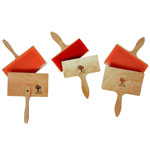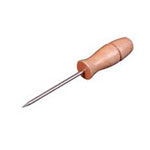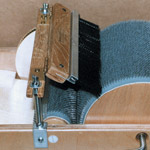Selecting a Carder
Selecting a Drum and Hand Carder, Buying a Drum and Hand Carder & General Information
This page will give you an introduction to selecting a drum Carder, selecting hand carders, buying a drum carder, buying hand carders touching on the types of carders, technical terms, attachments, options and considerations in choosing a carder.
- Selecting a Drum Carder
- Buying a Drum Carder
- Drum Carder Information
- Selecting Hand Carders
- Buying Hand Carders
- Hand Carder Information
- General Carding Information
General information
Carding is a process that takes loose fibers and arranges them into a roughly organized preparation that you can then use for many crafting purposes. For spinning yarn, carded and combed preparations affect the resulting yarn that is produced. Carding is an “inclusive” process; it has less ability to remove vegetable matter (VM) than combing but also reduces waste, as you can incorporate shorter fibers with the longer ones. The roughly organized fibers hold air and nepps, which produces a bouncy, insulating, and slightly textured yarn that is prone to pilling. When commercially prepared, these fibers are referred to as ‘rovings’. Carded fibers are particularly good for spinning, needle felting, and wet felting.
Carding of wool can either be done "in the grease" or not, depending on the type of machine and on the spinner's preference. "In the grease" means that the lanolin that naturally comes with the wool has not been washed out, leaving the wool with a slightly greasy feel. Note that spinning in the grease does not necessarily mean that you must go directly from sheep to wheel! We recommend a cold soak of all fleece before spinning in the grease in order to remove dirt, dust, excrement, and suint. Suint is sweat; it is sticky, holds on to dirt, and makes drafting difficult, but is easily dissolved in cold water. Additionally, singles spun from a dusty fleece act as a file against any point of contact it makes with the wheel. This can cause accelerated wear of thread guides and orifice openings. You can avoid this step by being selective with the fleece you choose- choose a coated fleece from a breed of low-medium lanolin production for easiest spinning!
Hand carders (and drum carders too, though the directions may not recommend it) can be used to card lanolin rich wool. A major benefit of working with the lanolin still in the wool is that it conditions both your hands and your yarn. In combination with high twist spinning you can accomplish a semi-waterproof yarn for hard wearing outerwear.
A large variety of fibers can be carded, anything from wool, to dog hair, to llama, to soy fiber, to polyester! Carding is best suited for fibers that are 4-5 inches in staple length or less. Cotton and wool are the most common fibers to be carded.
Not all fibers are carded; Flax and other bast fibers, for example, are retted then threshed. Longwools like Wensleydale are difficult to card because of their excessive length. If you enjoy spinning longwools and want to card them, find a local source that shears twice a year for more manageable fiber length.
Carding can also be used to create blends of different fibers or different colors. The process of carding mixes up the different fibers, thus creating a homogeneous mix of the various types of fibers, at the same time as it orders them and gets rid of the tangles.
In addition to spinning, weaving and felt making, carded fibers can be used in a variety of other projects. Rovings look great when couched into embroidery designs or added to sewing projects as needle felted embellishments. The two main ways to card fibers are by hand and by machine.
Watch this video!

Hand Carders
Hand Carders are a pair of wooden paddles covered in a pin cloth. The carders are not dissimilar to slicker style dog brushes. The pins are equally spaced over the cloth and when the carders are loaded with fiber and pulled against each other the fibers are teased open and roughly organized.
See our large selection of hand carders....
Hand carders are used two at a time to brush the wool between them until all the fibers more or less align in the same direction. To card, the person carding holds a carder in each hand. The carder in their non-dominant hand rests on their leg. They place a small amount of fiber on this card and pull the other carder through, while taking care to catch some of the fibers. By catching some fibers on the moving card, the fibers are separated, which allows vegetable matter to fall out, and they are aligned. Catching too many fibers makes it hard to pull the carders apart.
This process, repeated many times, transfers small amounts of the wool to the other carder. Once all the wool has been transferred, the person carding repeats this process until all the fibers are aligned and the fiber is satisfactorily clean of debris.

See our large selection of hand carders....
Selecting Hand Carders
Hand carders can be either flat backed or curved, which is a matter of personal preference. Individuals with weakness or injury in the wrist may find a curved back carder more ergonomic for their needs.
Size is also a factor to consider. Small carders won't hold as much fiber but are physically easier to handle. If you don’t have any upper arm strength, a smaller size carder would be appropriate so that you can card for longer stretches of time.
There are carders with large, widely spaced teeth and carders with fine, closely spaced ones. The ones with the larger, widely spaced teeth are better for working with fiber that is coarse, tangled, or very lumpy. Carders with fine, closely set teeth are better for fibers that are very delicate, such as angora, cotton, or down fibers. One of the best all-around choices for a beginner is a pair of medium or fine gauge wool carders. Please refer to the end of this page for information on how to select carding cloth TPI.

Drum Carders
It is best to use fleece that has been pre-washed and scoured because it cards easier and puts less wear on the machine. Fibers are fed into the machine by placing them under the small drum, called the licker. The licker slowly feeds the fibers onto the main drum and in the process of transferring them the fibers are straightened out and made more orderly. The longer the fibers stay under the licker the more they are teased open before being transferred onto the larger drum. Most drum carders can be adjusted to feed into the machine faster or slower, but some cannot be.
Pay attention to the features of the carder you are considering; if it does not specify that the intake speed (often referred to as “ratios”) is adjustable or indicates it is designed for blending purposes then it may be ill-suited to processing fleeces.
When the fiber comes off the drum, it is in the form of a batt – a flat, orderly mass of fibers. The batt is the length of the circumference of the big drum. When carding is complete, a doffer pin or batt picker is used to remove the fiber from the Drum Carder.

Selecting a Drum Carder
Which carder is best for me? It depends on a number of factors; consider these when choosing a drum carder:
-
Quantity of fiber: a person who cards efficiently can usually card one pound of clean fleece per hour on a medium to large size manual drum carder. Someone with a large flock will usually find that sending fiber off to me milled professionally is worth the cost.
-
Manual vs electric: electric carders are more expensive than manual carders, but also work more quickly. Consider the value of your time.
-
Size: drum carders can come as small as 4 inches wide and sometimes as wide as 16 inches. Wider carders hold more wool and make larger batts, and can expedite the processing time.
-
Fiber types: refer to the bottom on the page for selecting carding cloth TPI.
If you will be doing a small amount of blending or are just getting started, then a small hand crank drum carder will suffice. Generally speaking, when it comes to drum carders, you get what you pay for. See our large selection of drum carders....
Drum Carding Accessories
DOFFER/CLEANING BRUSH:
Curved back brush used to clean hand carders and drum carders

DOFFER STICK/DOFFER PIN:
For removal of batt from drum carder

KNUCKLE-SAVING BATT PICKER:
A much needed variation of the doffer stick, this tool saves your knuckles from painful contact with the teeth of your drum carder when removing the batt from the large drum.

TEASING TOOL:
You might call this a single flat hand card, but you use it in a different way. Clamp the tool near your drum carder or even near where you are hand carding and pull your wool over the teeth to open ends and begin the process of cleaning and carding. Both hands are free to do this since the tool is clamped. Makes for faster, more efficient carding.

DRUM CARDER BRUSH ATTACHMENT:
A brush attachment will help to tame fine fibers that tend to gather on the licker, and presses fibers into the tines of the cloth so you can fill them further. With all fibers, a thicker, denser and more uniform batt is produced by using the attachment.
Selecting Carding Cloth
-
45-54 TPI: used for more coarse, open fibers, as well as rough blending. Good for primitive breeds with high micron count above 30.
-
72 TPI: a good all-around option that works best for coarse to medium fibers with a micron count between 20-30. Can also be used for finer fibers, but may require more passes to obtain a smooth preparation
-
90-120 TPI: especially good for fine fibers and downs with micron count below 20.
-
190-255 TPI: should only be used for short, extra fine fibers such as cotton and animal down. *A note about carding cotton: cotton tends to be very short and has little tooth (tooth refers to the scales on the outer shell of an individual strand of fiber, which allows it to stick to other fibers). Because of this it is not typically carded on a drum carder, as it will be virtually impossible to remove cleanly from the drum.
Tpi stands for teeth per square inch. It is used in reference to the carding cloth used on your drum carder, hand carders, or flicker. How many you need depends on what fiber you want to card. Keep in mind that not one set will work perfectly for every fiber but, for the most part a pair ranging from 72-112 TPI will work on most wool.
Wash & Prepare Fleece
General information: Carding of wool can either be done "in the grease" or not, depending on the type of machine and on the spinner's preference. "In the grease" means that the lanolin that naturally comes with the wool has not been washed out, leaving the wool with a slightly greasy feel. Hand carders (and small drum carders too, though the directions may not recommend it) can be used to card lanolin rich wool.
A major benefit of working with the lanolin still in the wool is that it leaves you with soft hands.

